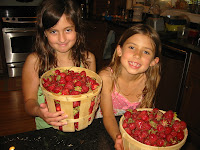 I made my first batch of chevre last weekend, and it was really tasty and relatively easy. The hardest part has been milking Latte and saving enough milk to actually be able to use.
I made my first batch of chevre last weekend, and it was really tasty and relatively easy. The hardest part has been milking Latte and saving enough milk to actually be able to use.I got my cheese supplies from
 cheesemaking.com, along with a book and dvd that came in a beginner's kit. I'd highly recommend both, as they made the process much easier. I also really appreciated the advice of friends and the wonderful Fias-Co Farm website.
cheesemaking.com, along with a book and dvd that came in a beginner's kit. I'd highly recommend both, as they made the process much easier. I also really appreciated the advice of friends and the wonderful Fias-Co Farm website. I thawed the milk overnight in the refrigerator, and the longest part of the process was bringing the milk up to the proper temperature. I ended upovershooting a bit and had to let it cool down some before adding the culture. I then let it set for 12 hours. By about 11pm that night, I was ready to ladle the curds into a cheesecloth and hang overnight to finish draining the whey. Unfortunately, I didn't think to save any of the whey for the piggies or baking, but I will next time.
I thawed the milk overnight in the refrigerator, and the longest part of the process was bringing the milk up to the proper temperature. I ended upovershooting a bit and had to let it cool down some before adding the culture. I then let it set for 12 hours. By about 11pm that night, I was ready to ladle the curds into a cheesecloth and hang overnight to finish draining the whey. Unfortunately, I didn't think to save any of the whey for the piggies or baking, but I will next time. I ended up splitting the batch in two so I could make one plain and one herbed chevre, knowing Jules really wanted her own plain goat cheese. To flavor mine, I used fresh parsley and chives from the garden and a clove of minced garlic. Mmmmmm! We've been enjoying fresh goat cheese all week! I'm looking forward to making yogurt this week flavored with our delicious homegrown black raspberries.
I ended up splitting the batch in two so I could make one plain and one herbed chevre, knowing Jules really wanted her own plain goat cheese. To flavor mine, I used fresh parsley and chives from the garden and a clove of minced garlic. Mmmmmm! We've been enjoying fresh goat cheese all week! I'm looking forward to making yogurt this week flavored with our delicious homegrown black raspberries.




























